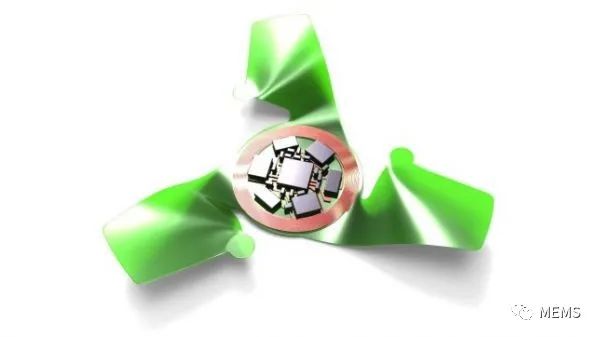According to a report by Scientific American on September 22, when maple trees begin to release their “winged” seeds, these seeds spiral gently down from the branches to the ground. Inspired by the aerodynamic characteristics of these helicopter-like samaras and other gliding tree species, engineers claim to have created the smallest wind-powered flying machines ever made, which they call “micro aerial vehicles.”

Simulation magnification of the “micro aerial vehicle” carrying microchips
Reports indicate that the largest of these winged devices is about 2 millimeters long, roughly the size of a fruit fly. The smallest “micro aerial vehicle” is only a quarter of that size. They are small enough to float like seeds but large enough to carry tiny microchips. These microchips are equipped with sensors and wireless transmitters that can collect information about the surrounding environment and send this data to scientists. John Rogers, a physical chemist at Northwestern University, stated that a large number of “micro aerial vehicles” could be deployed from the air and allowed to disperse across vast areas using wind power. He also mentioned, “Then, you can use them to build a sensor network for mapping environmental pollution, disease spread, biological hazards, or other information graphics.” Rogers and his colleagues described these machines in a paper published in the September 22 issue of Nature.
To help these peculiar devices descend as stably as possible, engineers first analyzed the shapes of seeds that rely on wind for dispersal, such as those of the bigleaf maple, ash-leaved maple, and the seeds of woody vines from the genus Acer. They then used computer simulations to model the airflow around objects that have shapes similar to these seeds but with slightly different geometries. This process allowed researchers to refine multiple designs until the “micro aerial vehicles” descended more stably and slowly than plant seeds. Reports indicate that in order for these devices to monitor large areas, Rogers and his colleagues must mass-produce them—if they can utilize existing facilities and processes to manufacture integrated circuits, this task could be easier. However, current production methods primarily create flat shapes, while the design of the “micro aerial vehicles” is three-dimensional. To solve this problem, engineers manufactured two-dimensional “micro aerial vehicles” and then adhered them to a layer of elastic material called elastomer. When they relaxed this material, it would bend, allowing these micro devices to take on their final three-dimensional shape. Rogers acknowledged that the “micro aerial vehicles” are still in the proof-of-concept stage. However, Rogers and his team plan to conduct field tests soon. Of course, allowing these micro machines to scatter in the natural environment seems unsustainable. To avoid disrupting local ecosystems, Rogers and his colleagues chose to manufacture the “micro aerial vehicles” using biodegradable and environmentally friendly polymers, conductors, and circuit chips.
